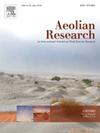Suspended sediment transport over the lee slope and forest canopy downwind of a large Blowout/Parabolic dune
IF 3.4
3区 地球科学
Q2 GEOGRAPHY, PHYSICAL
引用次数: 0
Abstract
Green Mountain Beach Dune is a large trough blowout migrating into a deciduous forest on the southeast shore of Lake Michigan, USA. Video cameras focused on the lee-slope of the dune recorded suspended sand transport in turbulent eddies rotating around both horizontal and vertical axes. A line of cups mounted on posts captured grainfall on the lee slope during a high wind event on November 21, 2017. Sediment mass in these traps decreased exponentially with distance from the brink. The relatively high half-length (distance at which 50 % of the sand has been deposited) of 6.2 m suggests that turbulence aids sand suspension. An array of grainfall traps in the forest beyond the base of the lee slope was sampled during 26 intervals over 30 months. Sediment masses in the forest traps decreased exponentially with distance from the dune with a mean half-distance of 46.7 m when leaves were off the trees and 62.6 m when leaves were on. We hypothesize that turbulence above the forest aids in suspending sand which also bounces off leaves and branches along the canopy. Sand in the grainfall traps fines with distance from the dune brink more rapidly in the lee slope than in the forest traps. Transport of sand beyond the lee slope plays a rather small part in the overall dune budget. However the relatively long distances of transport suggest that sand deposited within bogs or lakes can be a proxy for aeolian activity in an upwind dune.
大型抛物沙丘背风坡和林冠下风的悬沙输运
绿山沙滩沙丘是一个巨大的槽状沙丘,向美国密歇根湖东南岸的落叶林中迁移。摄像机集中在沙丘的背风坡上,记录了围绕水平轴和垂直轴旋转的湍流漩涡中悬浮沙粒的运输。2017年11月21日,大风期间,一排安装在柱子上的杯子捕捉了背风坡上的颗粒。这些圈闭中的沉积物质量随着离边缘的距离呈指数递减。相对较高的6.2米半长(50%的沙沉积的距离)表明湍流有助于沙的悬浮。在30个月的时间里,在背风坡底部以外的森林中,以26个间隔取样了一系列的颗粒捕集器。随着离沙丘距离的增加,森林捕集器沉积物质量呈指数递减,落叶时平均半距离为46.7 m,落叶时平均半距离为62.6 m。我们假设森林上方的湍流有助于悬浮沙子,这些沙子也会沿着树冠从树叶和树枝上反弹。随着距离沙丘边缘的距离增加,背风坡上的沙粒沉降比森林中的沙粒沉降更快。背风坡以外的沙输运在整个沙丘收支中起着相当小的作用。然而,相对较长的运输距离表明,在沼泽或湖泊中沉积的沙子可以代表逆风沙丘的风成活动。
本文章由计算机程序翻译,如有差异,请以英文原文为准。
求助全文
约1分钟内获得全文
求助全文
来源期刊

Aeolian Research
GEOGRAPHY, PHYSICAL-
CiteScore
7.10
自引率
6.10%
发文量
43
审稿时长
>12 weeks
期刊介绍:
The scope of Aeolian Research includes the following topics:
• Fundamental Aeolian processes, including sand and dust entrainment, transport and deposition of sediment
• Modeling and field studies of Aeolian processes
• Instrumentation/measurement in the field and lab
• Practical applications including environmental impacts and erosion control
• Aeolian landforms, geomorphology and paleoenvironments
• Dust-atmosphere/cloud interactions.
 求助内容:
求助内容: 应助结果提醒方式:
应助结果提醒方式:


